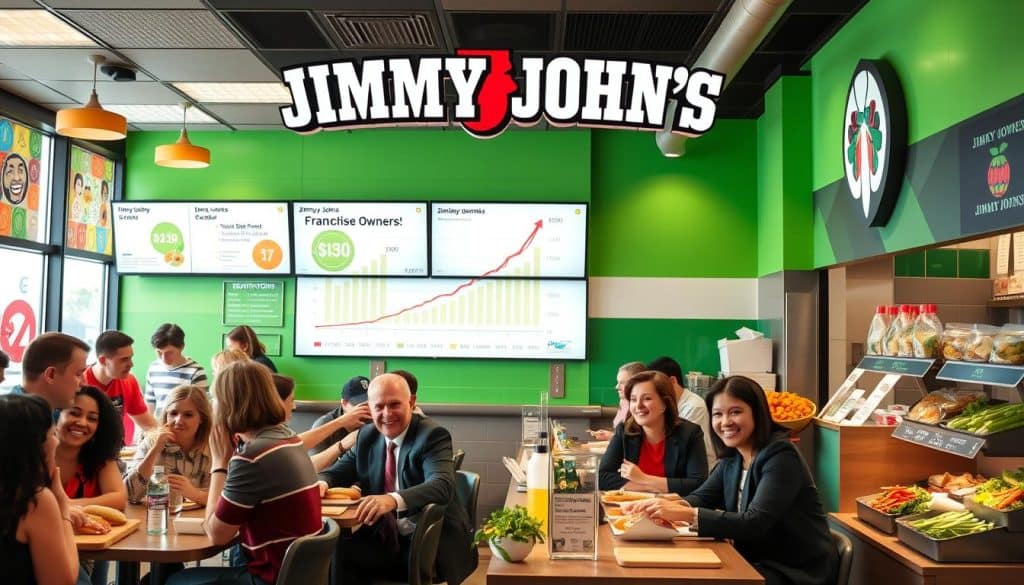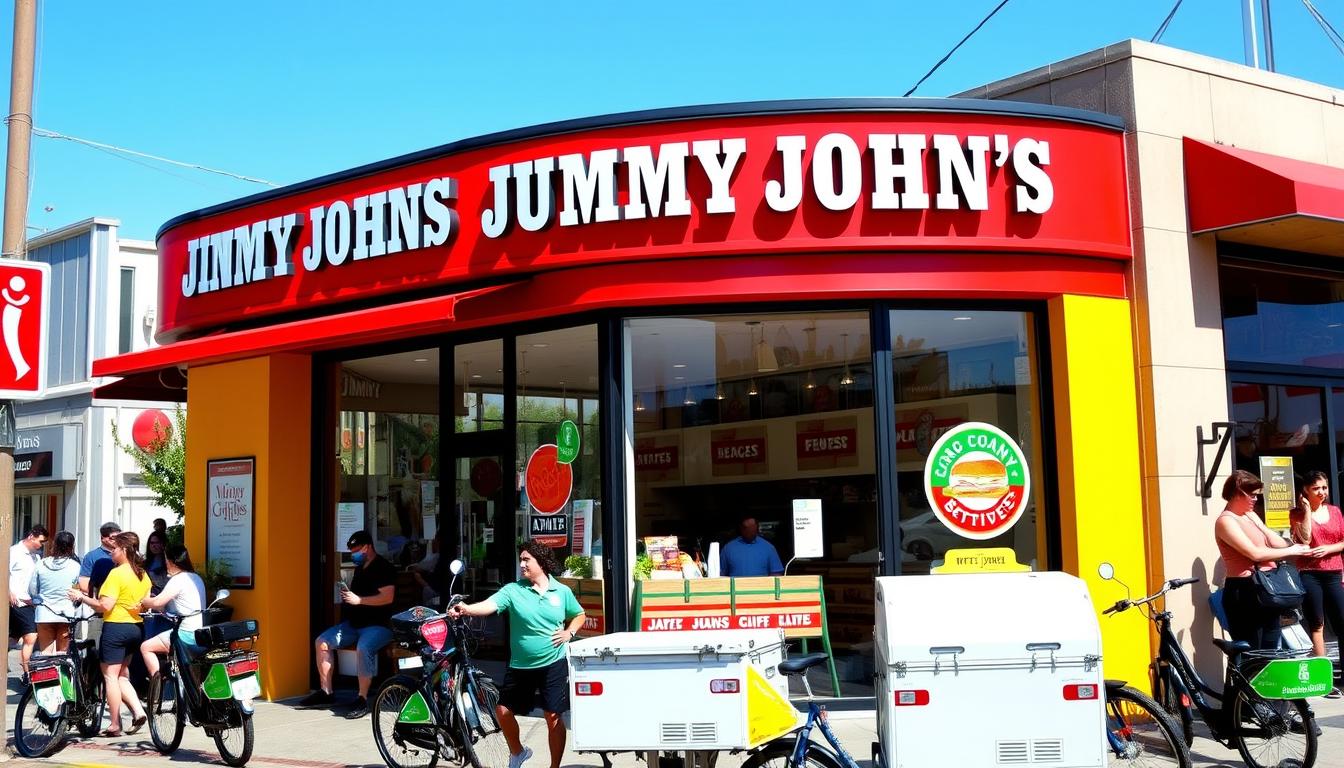Ever thought about starting a sandwich shop in America’s quick-service restaurant world? It might be easier than you think. Jimmy John’s, famous for its *fresh sandwiches* and *super-fast service*, offers great opportunities for franchisees. We’ll dive into the costs, steps, and tips for owning a Jimmy John’s franchise.
Key Takeaways
- The initial investment for a Jimmy John’s franchise ranges from $361,000 to $674,000.
- Franchisees benefit from an average annual revenue (AUV) of approximately $978,000.
- Owning a Jimmy John’s franchise entails a royalty fee of 6% along with an additional 2% for brand marketing.
- The franchise boasts a relatively low 3-year failure rate of 9%, compared to the industry average of 11%.
- Investors need a net worth between $500,000 and $1 million, with liquid assets ranging from $100,000 to $250,000.
Overview of Jimmy John’s Franchise Model
The jimmy john’s franchise has a well-defined model that has worked well from the start. Knowing the brand’s history helps us understand its current structure and support.
Brief History of Jimmy John’s
Jimmy John’s started in 1983 in Charleston, Illinois, as a single sandwich shop. It began franchising in 1994 and quickly grew. Now, it has over 2,800 locations, with 98% being franchises.
This growth shows the brand’s appeal and success. It’s a sign of the franchise’s strong business model.
Business Structure and Support
Franchisees of jimmy john’s get a lot of support to help them succeed. They get training on marketing and daily operations. They also get help with supply chain management and more.
This support keeps the brand experience the same everywhere. It helps franchisees run their businesses well.
Key Differentiators in the Market
What makes jimmy john’s stand out? It’s their fast service, promising delivery in just 30 seconds. They focus on quality meats and freshness, with a menu that appeals to many.
This focus on efficiency and quality makes jimmy john’s a strong competitor. It sets them apart in the quick-service industry.
Initial Investment and Franchise Costs
Starting a Jimmy John’s franchise requires understanding the costs involved. The initial investment ranges from $361,200 to $674,200. This includes several key components for success.
Breakdown of Startup Costs
The costs for a Jimmy John’s franchise start with a $35,000 initial fee. This fee can drop to $10,000 with certain incentives. Franchisees need at least $200,000 in liquid assets and a net worth of $1,000,000.
Other costs include real estate, equipment, and leasehold improvements. These add up to the estimated investment range.
Ongoing Fees and Royalties
After opening, franchisees pay ongoing fees. This includes a 6% royalty on gross sales. There’s also an advertising fund fee of 4.5% of weekly sales.
Incentives can lower these fees in the first years. For example, the royalty fee can drop to 1% in the first year. This helps with the financial load at the start.
Financing Options Available
There are several financing options for a Jimmy John’s franchise. Franchisees can look into loans or find investor partners. It’s recommended to have at least 20% of the investment as equity.
This financial plan helps manage startup costs. It also ensures the franchise requirements are met.
Steps to Become a Jimmy John’s Franchisee
Becoming a Jimmy John’s franchisee involves several steps. These steps ensure candidates are well-prepared for the journey. Knowing these stages helps navigate the process smoothly.
Initial Inquiry and Application Process
Those interested in owning a Jimmy John’s location can start by submitting an online inquiry. This first step is the foundation of the application. After the inquiry, applicants fill out a detailed form. They share their business experience and financial capabilities.
This information helps Jimmy John’s determine if the candidate is a good fit.
Franchise Disclosure Document (FDD)
The Franchise Disclosure Document (FDD) is key in the franchise process. It provides vital information about the franchise system. This includes costs, obligations, and the company’s financial history.
Reviewing the FDD is important for anyone interested in starting a Jimmy John’s franchise. It highlights investment risks and responsibilities.
Signing the Franchise Agreement
After completing the previous steps, the next step is signing the franchise agreement. This document outlines the rights and obligations of the franchisee. It’s important to understand this agreement well.
Location and Site Selection Process
Choosing the right spot for a Jimmy John’s franchise is key. It involves looking at traffic, visibility, and competition. High foot traffic areas, like shopping centers, can boost sales. Easy access is also important for customer convenience.
Factors to Consider for a Prime Location
Understanding the area around your franchise is vital. Look at foot traffic and nearby businesses. Knowing jimmy john’s franchise requirements for location can help your brand stand out.
Demographic Analysis and Market Research
Doing deep market research helps pick a good spot. Learn about local tastes and eating habits. This lets you offer what customers want. Knowing the community helps attract and keep customers.
Training and Support for Franchisees
Jimmy John’s franchisees rely on the brand’s training and support for success. New owners get a detailed training program. It teaches them the skills needed to excel in the quick-service industry.
This training focuses on making sure franchisees can manage their locations well. It’s all about preparing them for the job ahead.
Overview of Initial Training Programs
Every franchisee goes through a deep initial training. It mixes classroom learning with real-world experience in a corporate store. The goal is to teach them how to run their business well.
They learn about operational procedures, customer service, and menu management. This foundation helps them start strong. Jimmy John’s aims to set them up for success.
Ongoing Support and Resources
Support for franchisees doesn’t end after the initial training. Jimmy John’s keeps providing resources like regular updates and marketing tips. This helps improve franchise performance.
Franchisees also get to connect with other owners. They can share ideas and solve problems together. This support helps them grow and overcome challenges.
Marketing and Promotional Strategies
Marketing is key for Jimmy John’s franchise success. Franchisees get a lot of help with brand tools. These tools help create marketing plans that match national ads. They also have templates for making local marketing materials.
Utilizing Jimmy John’s Brand Tools
Jimmy John’s strong brand helps franchisees a lot. They get many marketing resources to fit into the brand plan. Using these tools, they can make special promotions for their area.
This not only boosts sales but also makes customers loyal to the brand.
Local Marketing Efforts
Franchisees are urged to do local marketing that fits their area. They can join community events and partner with local groups. This helps them build connections and get noticed.
Advertising that targets local people makes their marketing even better. This way, franchisees help the brand grow while meeting their customers’ needs.

Operational Guidelines and Standards
Keeping a franchise running smoothly is key to success. Jimmy John’s franchisees must follow certain rules to stay competitive. These rules cover staff leadership, inventory, and customer service.
Each part is important for keeping the brand’s good name and making money.
Daily Operations and Management
Good daily management is essential for a franchise to thrive. It means having a skilled team, the right amount of stock, and top-notch customer service.
By following the best practices, franchisees can offer consistent quality. This builds customer loyalty. A strong operational plan and daily management can really help a franchise grow.
Compliance and Quality Control
Following the rules ensures customer safety and satisfaction. Regular checks and reviews are needed to keep quality high.
Franchisees must also follow health laws to avoid problems and keep customers happy. Training and checking staff regularly helps ensure the brand’s quality is met every day.
Success Stories of Franchise Owners
Looking at successful franchise owners gives us insights into what makes jimmy john’s franchise profits soar. The Tomey Group is a great example. They started in 2003 with Fawzi Tomey opening the first Jimmy John’s in Novi, Michigan. Despite starting with just a few thousand dollars a week, they hit $20,000 weekly in a year.
Case Study: A Profitable Jimmy John’s Location
The Tomey Group has grown from one store to 48 across Michigan. By May 2023, they changed their menu and strategies, boosting revenues to over $41 million. They introduced new items like the Firecracker Wrap and limited-time offers to excite customers. They also diversified, investing in Chicken Guy and real estate, showing the value of different income streams.
Lessons Learned from Successful Franchisees
The Tomey Group’s success shows the power of being adaptable and focusing on quality. Successful owners stress the importance of excellent customer service. This builds a loyal customer base, essential in the fast-growing fast food market of 2023.
Keeping customers happy is key to jimmy john’s success. This is true for all profitable locations that focus on customer engagement and creative marketing. It helps them stay ahead in a changing market.

Common Challenges and Solutions
Owning a restaurant franchise like Jimmy John’s comes with its own set of challenges. Franchisees face issues like managing labor costs and dealing with supply chain problems. They also need to keep customers coming back. Spotting these problems early is key to finding solutions.
Knowing these challenges helps both current and future franchise owners. It prepares them for what’s ahead.
Potential Issues in Franchise Management
Managing a franchise can be tough, balancing work efficiency with keeping customers happy. Jimmy John’s franchisees must follow strict rules, which can make it hard to keep up with market changes. High food costs and relying on specific suppliers also affect profits.
Franchise owners need strong strategies to stay profitable and successful.
Resources for Overcoming Obstacles
But, franchisees have many resources to help them. Tools like Macromatix make scheduling and inventory easier, cutting costs and waste. Mentorship programs and support teams from the corporate office offer great advice.
By using these resources, franchise owners can handle business challenges better. This increases their chances of success in the long run. For more on franchisee concerns, check out this link.





